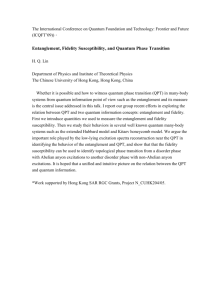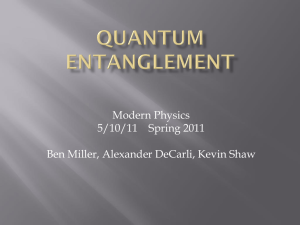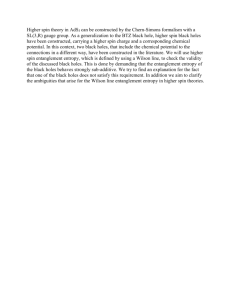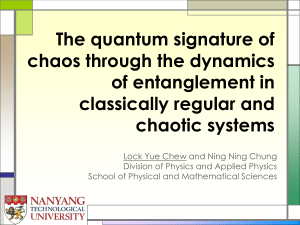Sabre Kais D f Ch i Department of Chemistry Purdue University West
advertisement
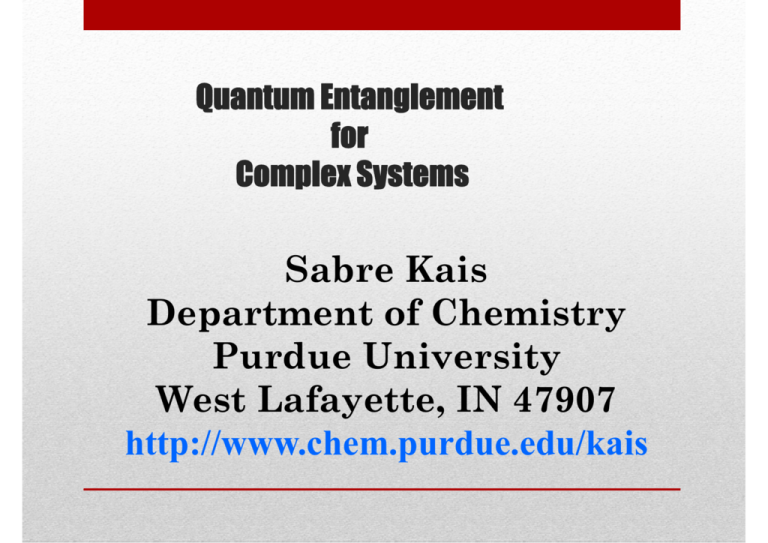
Quantum Entanglement
for
Complex Systems
Sabre Kais
Department
off Ch
Chemistry
D
i
Purdue University
West Lafayette, IN 47907
http://www.chem.purdue.edu/kais
What if there is never a
quantum computer?
Superposition
Interference
Entanglement
Quantum Information for Chemical
and Biological Systems
To understand the role of coherence and entanglement in
photosynthesis, mechanism with which birds determine magnetic
north
h and
d chemical
h i l reactions
i
How are special quantum features useful in
t
ti ?
quantum
computing?
Quantum Superposition: helps the Quantum Computer hold
large numbers of values simultaneously in a single register
made up of relatively few qubits.
Quantum Interference: helps to determine a result that
depends on all intermediate results, without having to
reveal those intermediate results(avoid premature
collapse of wavefunction)
Entanglement: enables the linkage of quantum registers
so that whenever an answer f(x) appears in one
i t
l
d t
i
th x that
th t
register,
we can always
determine
the
generated it
Wh t iis Entanglement?
E t
l
t?
What
Einstein-Podolsky-Rosen
y
((EPR)) Paradox ((1935))
Can Quantum-Mechanical Description of Physical Reality Be Considered Complete?
The principle of reality: individual
particles possess definite properties
even when
they’re
h th
’ nott being
b i observed.
b
d
The localityy p
principle:
p information
from a measurement in one of two
isolated systems cannot produce real
change
h
iin the
th other,
th especially
i ll
superluminally (faster than c).
The quantum-mechanical description of reality given by the
wave function is not complete, that is, there must be
Hidden Variables that we don’t know about and hence don’t
measure that cause the uncertainty.
Local realism is out
John Bell showed in a 1964 paper entitled
"On the Einstein Podolsky Rosen paradox,”
that local realism leads to a series of
requirements—known as Bell’s inequalities
John Bell (1928-1990)
(
)
Alain Aspect
p has pperformed numerous
beautiful experiments, proving
conclusively that our universe violate
alities big time.
time And
Bell’s Ineq
Inequalities
quantum mechanics explains the
effects qquite nicelyy
Alain Aspect (1947-)
Q
Quantum
t
Entanglement
E t
l
t and
d Electron
El t
Correlation
C
l ti in
i Molecular
M l l Systems
S t
Hefengg Wangg and Sabre Kais*
Department of Chemistry, Purdue University, West Lafayette, Indiana 47907, USA
The configuration
g
interaction ((CI)) wave function is entangled
g
since it violates Bell’s
inequality. Entanglement is related to electron correlation and might be used as an
alternative measure of the electron correlation in quantum chemistry calculations.
E(a b – a c + b d + c d )= E(a ,b ) – E(a ,c )+ E(b ,d ) + E(c ,d ) ≤ 2
where E(a ,b ) is the mean value of the product of the outcomes of two spin measurements
along the direction a and b
Israel Journal of Chemistry Vol. 47 pp. 59–65 (2007)
Entanglement
• The state of a composite quantum system is the
tensor product of subsystems
• There exist states of many-qubit systems that
cannot be broken down into a tensor product
e.g there does not exist :
• We call these kinds of states entangled states
Measuring Entangled State
For a two-qubit
q
system,
y
, there are
four entangled states named Bell
states:
After measuring an entangled pair
for the first time, the outcome of
the second measurement is known
100%
Quantum Teleportation Across the Danube
quantum teleportation over 16 km.
A real-world experiment marks a step towards worldwide quantum
communication
communication.
Anton Zeilinger et. al. Nature 430, 849 (2004)
Xian Min Jin,
Xian-Min
Jin et
et. Al
Al. Nature Photonics (2010)
( Quantum Teleportation over 16 km)
Requirements for Entanglement Measures
Separability:
S
bilit If ρ is
i separable,
bl then
h E(ρ)
E( ) = 0.
0
Normalization: The entanglement of a maximally state of two
d di
d-dimensional
i l systems
t
is
i given
i
by
b E=log
E l (d ).
)
No Increase Under Local Operations: Applying local
operations and classically communicating cannot increase E
Continuity: In the limit of vanishing distance between two
density matrices the difference between their entanglement
should tend to zero.
Additivity: A certain number N of identical copies of the state
ρ should contain N times the entanglement of one copy.
Subadditivity: the entanglement of the tensor product of two
states should not be larger that the sum of the entanglement of
each of the states.
Convexity: The entanglement measure should be a convex
function.
Von Neumann Entropy
Quantify Entanglement
(Entanglement of Formation)
• The pure state entanglement can be defined as the von
Neumann
entropy off either
N
i h off the
h two subsystem
b
A and
d
B
• Concurrence is the simply expression of Entanglement
S h ödi
Schrödinger
E
Equation
ti
Eigenvalues and Eigenvectors
(|10> |01>)
Ψ2=1/√2 (|10>-|01>)
00
00
01
10
11
01
10
11
1/√ (|10>-|01>)
(|10 |01 )
Ψ2=1/√2
Ψ1=1/√(1+α
1/√(1+α+2)(|11>
)(|11>-α
α+|00>)
S i S
t
Spin
Systems
A Spin Chain
h
with
h nearest neighbor
hb interaction
Hamiltonian
N is total spin number, γis the anisotropy parameter, Ji,i+1 =J(1+α) is the coupling constant between
sites hz is the interaction between external magnetic field and spin,
spin
impure site and it is J for other sites,
σis the Pauli matrix, λ=J/2h
O. Osenda, Z. Huang and S. Kais, PRA 67, 062321(2003)
Tuning
in Magnetic
System
g Entanglement
g
g
y
The system exhibit a quantum phase transition at a dimensionless coupling constant =1
O. Osenda, Z. Huang and S. Kais, PRA 67, 062321(2003)
As the
A
h system iis tunedd across
a quantum critical point, the
ground state and its
g
correlations undergo
qualitative changes
The same is true of the
entanglement
t l
t in
i the
th
ground state
8
a C (1)
ln a a c
3
Entanglement
g
can be used to
characterize/classify
phase transitions
Entanglement Calculations for
Quantum Dots
Q
Hubbard Hamiltonian of quantum dots
Entanglement for the ground state
Trj denotes the trace over all but the j-th site
J. Wang and S. Kais, Int. J. Quant. Information 1, 375 (2003)
Metallic State -> Insulating State
There is an abrupt jump of the entanglement when a
first order quantum phase transition occurs.
first-order
occurs
There is a block-block entanglement scaling
J. Wang and S. Kais, Phys. Rev. A 70, 022301 (2004)
Dipole
Systems
p
y
m
Qi Wei, Sabre Kais, Bretislav Friedrich and Dudley Herschbach
Arrays of ultracold polar molecules as platform to
i l
t a quantum
t
t
implement
computer
Q. Wei, et. al. J. Chem. Phys. 134, 124107 (2011)
Quantum Computation
with Cold Polar Molecules
Q
p
in an Optical Lattice
+V (~3kV)
E field due to dipole of its neighbors
E-field
E
| 10
Optical lattice
p depth
p ~ 100
K
Trap
| 0
| 1
-V
KCs ppolar molecule ((~104 total qqubits,, can
perform 105 CNOT, with decoherence ~5s)
Trapp of length
g ~5 mm
D. DeMille, PRL 88, 067901 (2002))
Hamiltonian for a Single Molecule
Hˆ
ε
P2
2m
2
Vtrap ( r ) BJ
Kinetic Trapping
energy potential
Rotational Electric
energy
field
Assume Separable
p
Rotational state HS
Hˆ S BJ 2 - με cos
Eigenfunctions : Pendular states
ε
μ
Entanglement
and Excitation
g
Dynamics in Light Harvesting
Complex
FMO
Complex
LH2
Complex
6
1
2
7
5
3
4
RC
Chromophore: Is the part of a molecule responsible for its color.
Th color
The
l arises
i
when
h a molecule
l
l absorbs
b b certain
i wavelengths
l
h
of visible light and transmits or reflects others. The
chromophore is a region in the molecule
molec le where
here the energ
energy
difference between two different molecular orbitals falls within
the range of the visible spectrum.
spectrum Visible light that hits the
chromophore can thus be absorbed by exciting an electron from
its ground state into an excited state.
state
Photosynthesis:
Is a chemical process that converts carbon dioxide into organic
compounds especially sugars,
compounds,
sugars using the energy from sunlight.
sunlight
Photosynthesis occurs in plants, algae, and many species of
bacteria.
Proteins are biochemical compounds consisting
of one or more polypeptides typically folded into
a globular form, facilitating a biological function.
A polypeptide is a single linear polymer chain of
amino acids bonded together by peptide bonds
between the carboxyl and amino groups of
adjacent
dj
t amino
i acid
id residues.
id
The sequence of amino acids in a protein is
defined by the sequence of a gene, which is
encoded in the genetic code
Objective
The existence of life on earth relies on the conversion of light energy into chemical
gy byy bacteria and plants.
p
g
energy
These natural organisms
execute the conversion with
extremely high efficiency.
• To understand the role of quantum coherence &
entanglement in complex systems such as
photosynthesis
• Photosynthesis is one of the most common
phenomenon
h
iin nature, but
b the
h detailed
d il d principles
i i l
of the whole process are still unclear.
• The energy transfer from the light harvesting
complex (LHC) to the reaction center (RC) is
amazingly high (almost 100%)
The energy transport in light-harvesting
complexes is extremely efficient
Could it be the case that entanglement is
responsible for this efficiency?
Process of Photosynthesis
• Green sulfur bacteria
• Energy flow
omit
Light→LHC
→ FMO* Complex
p
→RC
* FMO
=Fenna-Matthews-Olson
Experimental Rsults
• FMO has the function of a wire in the energy
gy transfer
• The transfer efficiency is 100%
• Direct evidence of long-lived coherence has been
experimentally demonstrated during the energy transfer at
T 77K
T=77K
G. Engel, et al. , Nature, 446, 782 (2007)
The Structure of FMO
Complex
• FMO protein of green
sulfur bacteria
• 3 monomers
• C3 symmetry
• Each monomer works
i d
independently
d tl
• 7 BChl molecules for
each monomer
http://en.wikipedia.org/wiki/Fenna-Matthews-Olson_complex
Detailed Structure of Each Monomer
http://en.wikipedia.org/wiki/Fenna-Matthews-Olson_complex
The Organization of Each Monomer
1
6
2
7
5
3
4
RC
• Site 1&6 combined
with the LHC
• Site 3&4 combined
with the RC
• Energy flows from site
1&6 to site 3&4
Seeking a minimal model for this quantum
system and its environment
• M
Must
st capt
capture
re and give
gi e insights into
p y
essential physics.
• Tells us which physical parameters lead
to qualitative
li i changes
h
in
i quantum
dynamics.
• Consider each site as a 2-level system
• Hamiltonian for the environmental phonons
• The
Th Hamiltonian
H ilt i off the
th system-environment
t
i
t coupling
li
• Site 6 initially excited:
• System Hamiltonian (unit: cm-1)
J. Adolphs and T. Renger; Biophysical Journal; 91, 2778–2797 (2006)
Severall approaches
S
h ffor d
dealing
li with
ih
this complex Hamiltonian
• Redfield Equation
q
• Assumption: the system-environment coupling is weak
• Förster Theory
• Assumption: the coupling within the system is weak compared to
the system
system-environment
environment coupling
• Hierarchical Equation of Motion (HEOM) Approach
• No previous assumptions
Model Details
• Using the over damped Brownian oscillator model; replace the
stick spectra with the Drude spectral density
• The correlation function can be written as
J. Zhu, S. Kais, P. Rebentrost and A. Aspuru-Guzik, Journal of Physical Chemistry B., 115:1531, 2011
Excitation Dynamics of FMO Complex
• ρ0={{0,0,…},
{{0,0,…}, …{0,0,…}} is system reduced density operator (RDO)
• All others are considered as auxiliary density operators (ADOs)
• The truncation level
• The truncation level of the correlation function is K
• The cut-off
cut off level of ADOs is at
• In our simulation: K=0 and
=4
Exitation Population During Transfer in FMO
1
6
2
7
5
3
4
• The coherence oscillation
y
rather
is due to the system
than the environment
• The oscillation time scale
is around 650fs, which is
consistent with the
experimental observation
J. Zhu, S. Kais, P. Rebentrost and A. Aspuru-Guzik, Journal of Physical Chemistry B. 115,1531 ( 2011)
Entanglement
• Method to calculate the p
pairwise concurrence in
FMO complex on the single excitation basis sets
Global entanglement:
Pairwise Entanglement Evolution in FMO Complex
• The total entanglement and the
pair sites at 77K
concurrence of p
when site 1 is initially excited
• The coherence oscillation also
exists in the entanglement
evo ut o
evolution
• They concluded that the
entanglement in FMO complex
can existed at long-range and
multipartite even at room
temperature.
M. Sarovar, A. Ishizaki, G. R. Fleming, and K. B. Whaley, Nature Physics, 6, 462 (2010)
Multipartite Entanglement
M
Meyer-Wallach
W ll h measure
Monotone
Monogamy of entanglement
Among three
A
h qubits
bi ABC,
ABC if A&B are maximally
i ll entangled,
l d then
h C
can not entangled with A&B
τA|B is measuring the entanglement of qubit A and B
Cayley map and Lie Groups
• Convex roof extension of entanglement monotones
Employ the Cayley map to obtain the unitary U which minimize the E(ρ)
J. Zhu, S. Kais, A. Aspuru-Guzik, S. Rodriques, B. Brock and P. J. Love;
Multipartite Quantum Entanglement Evolution in Photosynthetic Complexes, J. Chem. Phys.
Isolated System
1.0
Coupled System
1|2
1|3
Monogamy Bond
1|23
a)
6
5
0.0
1.0
1|2
2|3
Monogamy Bond
2|13
c)
d)
0.5
0.0
0.4
1|3
2|3
Monogamy Bond
3|12
e)
f)
0.2
0.0
0
400
800
1200
0
400
Time / fs
800
1200
2
7
b)
0.5
Enttanglemen
nt
1
3
4
• Entanglement evolution
of site 1, 2&3; Site 1
i i i ll excited;
initially
i d T=77K
• 1|23 larger than
monogamy bound
• 1|2 is the domain pair
• 2|3 has coherence
oscillation
Entanglement evolution for the site 6 initially excited at T=77K
T 77K
0.6
0.25
3|4
3|567
4|567
3|4567
1|4567
2|4567
0.15
En tanglem
ment
En tanglem
ment
0.20
0.10
0.05
0 00
0.00
0
200
400
Time / fs
600
800
0.4
0.2
00
0.0
0
200
400
600
Time / fs
• Left panel: entanglement evolution off the pathway; smaller
compared with that involved in the pathway
• Right panel: entanglement evolution related to site 3&4; pair 3|4
becomes the most significant
g
pair
p at the end
800
Entanglement for FMO
1
6
2
7
5
3
4
Multipartite Entanglement is Max along the excitation transfer pathway
Population and Entanglement Dynamics in
Light Harvesting Complex 2 LH2
LH2 consists of two structural units
(named after the positions of their absorption peak)
called B800 with 9 bacteriochlorophylls (BChls)
and B850 with 18 BChls.
Hamiltonian of LH2
Ei ~ site energy
Vij ~ induced dipole- induced
dipole interaction
J. Strümpfer and K. Schulten, Journal of Chemical Physics, 131, 225101 (2009)
Site Exciton Population at T = 300K
66 fs
128fs
68 fs
106 fs
104 fs
Entanglement Dynamics at T = 300K
Global entanglement:
2-sites entanglement (concurrence):
111 fs
61.20%
Entanglement Dynamics of LH2
Time Evolution of Density Matrix at T = 300K
Site Exciton Population at T = 77K
67fs
105fs
127 fs
Entanglement Dynamics at T = 77K
-33.37%
33 37%
Time Evolution of Density Matrix at T = 77K
New Structure of FMO Complex
• FMO protein of green
sulfur bacteria
• One additional 8th
BChl between each
monomer
• The 8th BChl is close
to the 1st BChl
http://www.ks.uiuc.edu/Research/fmo/index.html
System Hamiltonian
M. Schmidt am Busch, F. M¨uh, M. E. Madjet, and T. Renger, J. Phys. Chem. Lett. 2, 93 (2011).
J. Moix, J. Wu, P. Huo, D. Coker and J. Cao, arXiv:1109.3416v1
Quantum Mechanism for
Magnetorecption in Birds
The recent discovery that quantum coherence
plays a central role in excitonic transport in
photosynthesis invites us to explore other
places in biological systems where quantum
coherence is important.
• Understand the role of quantum
coherence and entanglement in the
bi l i l compass system.
biological
t
the p
potential role of a q
quantum
• Explore
p
phase transition in the local nuclear
environment.
environment
Radical Pair Mechanism
James Abraham “Abe” Pauls
Undergraduate Student from Goshen College
NSF REU Program
The RPM Model
B
Blue Photon
Entangled
Magnetic Moment Coupling
spin flip, transition to triplet state
Nuclear Spin
Singlet and triplet states will have different reaction products
Excitation and Electron Hole Transfer
Cryptochrome Molecule
13.3 Angstroms
Structure and Energy Levels
The Hamiltonian for the system is:
H=g B S j (B A j I j )
2
j1
I j is the
Where B is the Earth
Earth’s
s
(external)
magnetic
field,
field
single spin-1/2 nucleus, A j denotes the hyperfine coupling
tensor.
tensor
We use the numbers as:
B 0.5G
10G
0
0
A1 0 10G 0
0
0
0
5G 0
0
A2 0 5G 0
0
0
5G
G
K. Schulten
Schulten,, et. al. Biophysical Journal 78, 707, (2000)
The density
y matrix ((t)) is governed
g
byy the stochastic Liouville
Equation:
i
kS S
kT T
(t) H,
H (t) Q , (t) Q , (t)
2
2
Assuming the recombination rates are spin-dependent,
k kS kT
One can express
p
the density
y matrix in this form:
1 iHt/ S iHt/ kt
(t) e Q e e
N
With N is the number of nuclear spin states
(0) Q S Tr Q S
The singlet
g yyield S is defined as the amount of
products decaying via the singlet channel:
S
0
kS S(t)dt
Where S(t) is the fraction of the radical pairs in the
singlet state:
S
S(t) Tr Q (t)
1 kt 4 N 4 N S S
S(t) e QmnQmn cos[(wm wn )t]
N
m1 n1
Then we can get:
4N 4N
2
1
k
S
S
S
QmnQmn 2
N m1 n1
k (wm wn )2
Entanglement Dynamics of Avian
Magnetic Compass
Entanglement
g
=2
TA 2
Where Tr is the ppartial trace
of the density matrix
A
The Simplest Double Slit
Interference and Entanglement in Double
Photoionization
of the Hydrogen Molecule
Quantum Entanglement:
Hydrogen
y g atom:
H d
Hydrogen
molecule:
l l
=
_
Superposition
p p
of two electron states leads to non-local
correlations between spins
I t d ti to
Introduction
t COLTRIMS
Graphic of Cold Target Recoil Ion Momentum Spectroscopy
Young’ss Double Slit Experiment
Young
To make coherent
sources
D. Akoury et. al. Science 318, 949 (2007)
E
l
f Electron
El
Entanglement
as Measure of
Correlation
The correlation energy is defined as the difference
between the HF limit energy and exact solution of
nonrelativistic Schrodinger equation.
equation
Electron correlation is not directly observable.
Entanglement is directly observable and it is one of the
most striking properties of quantum mechanics.
Electron Correlation and
Entanglement for H2
Entanglement as a function of the
distance R between two spins for
different values of the magnetic
field strength B
E t l
Entanglement
t for
f H2
Huang and Kais, CPL 413, 1 (2005)
Summary
Entanglement
g
can be used to:
• Characterize/classify quantum phase transitions
• Perform quantum teleportation
• Perform quantum computing using ultracold polar molecules
• Understand complex processes such as photosynthesis,
mechanism with which birds determine magnetic north and
chemical reactions
• Measure electron-electron correlation
NSF Center for Quantum Information and
Computation for Chemistry
CCI Phase I
http://web.ics.purdue.edu/~kais/qc/
Alan Aspuru‐Guzik (Harvard) Kenneth R. Brown (Georgia Tech)
Daniel A Lidar (USC)
Daniel A. Lidar (USC)
Peter J. Love (Haverford)
Sabre Kais (Purdue)

